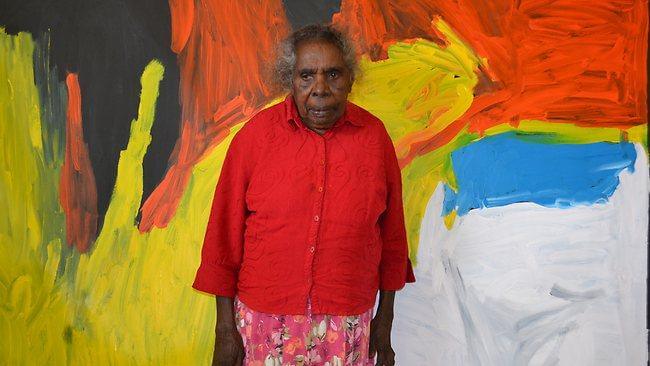Sally Gabori

Mirdidingkingathi Juwarnda Sally Gabori was born c. 1924 on Bentinck Island, in the Gulf of Carpentaria, off the coast of far-north Queensland, Australia. She was a Kaiadilt woman who spoke Kayardilt language. Her name, Mirdidingkingathi Juwarnda, comes from the Kaiadilt tradition, which stipulates that everyone is named according to their place of birth and their totemic ancestor. Therefore, Mirdidingkingathi indicates that Sally Gabori was born at Mirdidingki, a small creek located in the south of Bentinck Island, and that her “totem animal” is juwarnda or dolphin.
Largely isolated, with a population of 125 in 1944, the Kaiadilt were the last Aboriginal people of coastal Australia to establish lasting ties with the European. Sally Gabori and her family lived a traditional lifestyle, relying almost entirely upon their island’s natural resources. Like most women, she was in charge of fishing, maintaining the stone fish-traps that dotted the shores of the island, and of weaving natural fibers into baskets.
From the early 1940s onwards, the Presbyterian missionaries who in 1914 had settled on Mornington Island, to the north of Bentinck Island, tried unsuccessfully to convince the Kaiadilt to join their mission. Their attempts were in vain. However in 1948, following a cyclone and a tidal wave that flooded a large part of Kaiadilt land and contaminated their fresh water supplies, the 36 last surviving Kaiadilt residents, including Sally Gabori and all of her family, were evacuated to the Presbyterian mission on Mornington Island. This exile, which they believed would only be temporary, would ultimately last for several decades. When they arrived on Mornington, the Kaiadilt were housed in camps along the beach and the children were separated from their parents and installed in dormitories within the mission. They were forbidden from speaking their mother tongue, resulting in a fracture from their culture and traditions.
From the 1990s onwards, after many years of struggle for the recognition of Aboriginal land rights, Australia passed legislation which finally recognized the rights of the Kaiadilt to their land. A small outstation was established at Nyinyilki on Bentinck Island, allowing those Kaiadilt who so wished, including Sally Gabori, to return to their native island and stay there temporarily.






